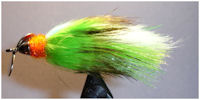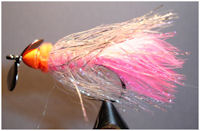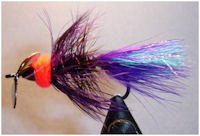 |

Basic Tying
Instructions
Anatomy of a
Fly
Salmon and
Steelhead Hooks
Fly Tying
Tools
Materials
Glossary

Fly Search
Match Flies to Species
Contributing Tyers
Show Your Flies Here

Steelhead Facts
Pacific Salmon
Facts
Tips and Techniques
Forum
Site Map

Flies
Issues
Photo Gallery
|
 |
|
 Pacific
salmon are andromedous fish who migrate vast distances in fulfilling a life
cycle that absolutely depends for its successful completion on their returning
to the same stream they departed years and thousands of miles earlier.
This life cycle obviously demands very precise and reliable ocean
navigation under all weather conditions.
One important direction-finding strategy that has been shown to be used
by migrating salmonids is solar location, which is challenging with frequently
overcast skies and several feet of ocean between the sun and the fish’s eye.
These technical issues can be addressed by using the ultraviolet portion
of the spectrum of sunlight, which penetrates clouds and water better than
longer wave lengths of light.
Salmon
eyes are adapted to detect and to polarize ultraviolet light; their ability to
utilize polarization, which can be used to more precisely determine the
directionality of light, provides further support for the hypothesis that UV
contributes importantly to salmon navigation.
Based upon the theory that salmon returning from a long and remarkably
accurate migration would be particularly attuned and sensitive to UV light, I
began incorporating UV materials into my Pacific salmon flies and noticed an
immediate improvement in their effectiveness for silvers, chums and pinks that
has been very consistent and sustained for the last three years. (I have not had
the opportunity to test this approach sufficiently on kings or sockeyes or to
test these flies enough on any salmon outside
Alaska.)
UV
materials are now an integral part of my Pacific salmon flies. Pacific
salmon are andromedous fish who migrate vast distances in fulfilling a life
cycle that absolutely depends for its successful completion on their returning
to the same stream they departed years and thousands of miles earlier.
This life cycle obviously demands very precise and reliable ocean
navigation under all weather conditions.
One important direction-finding strategy that has been shown to be used
by migrating salmonids is solar location, which is challenging with frequently
overcast skies and several feet of ocean between the sun and the fish’s eye.
These technical issues can be addressed by using the ultraviolet portion
of the spectrum of sunlight, which penetrates clouds and water better than
longer wave lengths of light.
Salmon
eyes are adapted to detect and to polarize ultraviolet light; their ability to
utilize polarization, which can be used to more precisely determine the
directionality of light, provides further support for the hypothesis that UV
contributes importantly to salmon navigation.
Based upon the theory that salmon returning from a long and remarkably
accurate migration would be particularly attuned and sensitive to UV light, I
began incorporating UV materials into my Pacific salmon flies and noticed an
immediate improvement in their effectiveness for silvers, chums and pinks that
has been very consistent and sustained for the last three years. (I have not had
the opportunity to test this approach sufficiently on kings or sockeyes or to
test these flies enough on any salmon outside
Alaska.)
UV
materials are now an integral part of my Pacific salmon flies.
Five years ago, when going
through the fly rack at a store in Anchorage before flying out on a silver
salmon trip, I bought a couple of egg sucking leeches that had a propeller on
the front of the fly.
I bought them
more as novelties than anything else.
On that particular trip the fishing was tough (sunny, hot, low water and
poor run of fish) and more out of frustration than any hope of success I worked
through the box and finally tied on one of the propeller flies.
I had a hook up on the second cast, my first in two days and caught some
fish with those two flies over the next two days until they were both destroyed
by use and fishing went back to being very slow for me.
When I got home, I worked out a way of
tying salmon flies that had a propeller on the front, free to spin against a
brass bead or cone that was firmly attached to rest of the fly so that it would
not migrate forward and obstruct the prop (see
Making Propeller Hooks, below).
I then began developing propeller flies for salmon that also incorporated
UV materials, were not excessively difficult to cast, were relatively cheap and
fast to tie, and worked well under a variety of water conditions (clarity, depth and
current speed).
For the last two
years, I have not been able to improve on the three basic patterns that have
resulted from this evolution and don’t expect the flies I carry for salmon in
Alaska in August to
change much in the future.
They cast
adequately with an eight weight rod throwing a weight forward or sink tip line
and function well dead drifted or stripped with slow or fast retrieves.
 The Rotabunny pattern is my
favorite.
When wet, it is slightly
more difficult to cast than conventional salmon flies, but casts well enough for
medium distances using an open loop or a Belgian cast. You get better with
practice. This fly has great action in the water, whether drifting or being
retrieved, and is incredibly durable.
The Pink Rotabunny now gets 80 percent of my silver salmon fishing time
and takes the vast majority of my silver and chum salmon. I take several dozen
of these on any August trip to
Alaska.
I tie three other color variations of the Rotabunny for unique uses and
conditions, but am not convinced that I really need them.
They do take fish and I take a few of each on every trip. The Rotabunny pattern is my
favorite.
When wet, it is slightly
more difficult to cast than conventional salmon flies, but casts well enough for
medium distances using an open loop or a Belgian cast. You get better with
practice. This fly has great action in the water, whether drifting or being
retrieved, and is incredibly durable.
The Pink Rotabunny now gets 80 percent of my silver salmon fishing time
and takes the vast majority of my silver and chum salmon. I take several dozen
of these on any August trip to
Alaska.
I tie three other color variations of the Rotabunny for unique uses and
conditions, but am not convinced that I really need them.
They do take fish and I take a few of each on every trip.
 The Rotapixie pattern is a
little easier to cast than the Rotabunny and is flashier and has more UV
reflection.
The Pink Rotapixie is my
son, Padraic’s, favorite silver salmon fly and he does quite well with it.
For those who are offended by propellers, find propeller flies unpleasant
to cast or don’t consider their use true fly fishing, the propeller and cone can
be omitted from these flies to make the Pixie series, which are still my most
effective non-propeller patterns (after all, they do still have the UV
advantage). I tie and carry four color patterns of both Rotapixies and Pixies;
again, pink is the best producer.
When I get tired of using heavy tackle and have caught a few fish on the
Rotabunnies, I can switch to a six weight and comfortably throw Pixies with
reasonable hope of success on lighter tackle. The Rotapixie pattern is a
little easier to cast than the Rotabunny and is flashier and has more UV
reflection.
The Pink Rotapixie is my
son, Padraic’s, favorite silver salmon fly and he does quite well with it.
For those who are offended by propellers, find propeller flies unpleasant
to cast or don’t consider their use true fly fishing, the propeller and cone can
be omitted from these flies to make the Pixie series, which are still my most
effective non-propeller patterns (after all, they do still have the UV
advantage). I tie and carry four color patterns of both Rotapixies and Pixies;
again, pink is the best producer.
When I get tired of using heavy tackle and have caught a few fish on the
Rotabunnies, I can switch to a six weight and comfortably throw Pixies with
reasonable hope of success on lighter tackle.
 The RotaESL (“Egg Sucking
Leech”) fly is now an old standby that started my propeller fly collection and
still takes fish. I carry only one color of this pattern (purple), although you
might want to try others. I think the important aspect of this fly is that it
has relatively little flash or UV and is dark and subtle.
In those rare instances where August salmon are too skittish to strike
the gaudier Rotabunnies and Rotapixies, this fly comes into its own.
It is also an excellent Alaskan trout fly, so switching to the RotaESL
when you want to catch fish but are beginning to lose hope that they will be
salmon, makes sense. The RotaESL (“Egg Sucking
Leech”) fly is now an old standby that started my propeller fly collection and
still takes fish. I carry only one color of this pattern (purple), although you
might want to try others. I think the important aspect of this fly is that it
has relatively little flash or UV and is dark and subtle.
In those rare instances where August salmon are too skittish to strike
the gaudier Rotabunnies and Rotapixies, this fly comes into its own.
It is also an excellent Alaskan trout fly, so switching to the RotaESL
when you want to catch fish but are beginning to lose hope that they will be
salmon, makes sense.
These three patterns with their color
variations as well as several Pixies will fit comfortably into one medium fly
box, simplifying my gear substantially while arming me well for August in Alaska.
Next Page>>
Making Propeller Hooks
|
|
 |